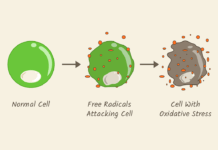The immune response is very complex as it can vary between individuals and can be affected by environmental factors, among other things. This is an important concept for dental hygienists to understand, as one of the components in the development and progression of periodontal disease is the host response to the pathogenic bacterial assault.
Immune variation can occur on an interindividual level, which refers to “variation between individuals,” but also can occur on an intraindividual level, which refers to “variation within an individual over time.”1
It is important to consider interindividual variations of immune response when considering risk factors for oral disease. More importantly, intraindividual variations can be easily overlooked and often missed.
For example, patients who have always presented with a healthy periodontium may start seeing changes in their oral health as they age. This can be due to multiple factors, and the immune response should be considered as one of those factors. Changes that occur with immune response as we age include:2
- The immune system becomes slower to respond
- Increased risk of developing autoimmune disorders
- The body may heal more slowly
- The immune system’s ability to detect and correct cell defects declines, increasing the risk of cancer
As you can imagine, these changes can affect a patient’s oral health as well. An interesting concept that has recently been researched is the seasonality of the immune response on an intraindividual level.
Seasonality of Immune Function
Studies have verified a difference in immune function depending on seasonality. In winter months (defined as December, January, and February), pro-inflammatory processes were more frequent when compared to summer months (defined as June, July, and August).1,3 Additionally, C-reactive protein levels were found to be higher in winter months than in summer months. This combination of data indicates a more inflammatory state in the winter than in summer.3
Diagnosis of certain autoimmune diseases shows a seasonal trend as well. For instance, type 1 diabetes (T1D) has a seasonal trend for diagnosis. A significantly higher diagnosis of T1D occurs in the fall and winter compared to the spring and summer. This trend has been observed across both the Northern and Southern Hemispheres.4,5 Nonetheless, further studies are needed to eliminate confounding factors and to determine if there is indeed a causal link.5
Another autoimmune disease that shows seasonal trends is multiple sclerosis (MS). Studies show seasonality has an effect on clinical manifestations of the disease, MRI brain lesions, and cytokine levels. As with T1D, further studies are needed to better identify causality and adjust for confounders that may be playing a role in the data gathered.6
Clearly, reasonable evidence exists to consider seasonality and disease onset and progression. It has also been postulated that seasonality of immune function plays a role in the incidence of respiratory viral infections, such as influenza and respiratory syncytial virus (RSV), during the winter months.7
Clinical Application
How is this information valuable in a clinical dental setting? First, it could be relevant as you work to determine causative factors for patients with gingivitis or those with periodontitis showing signs of progression.
Though no studies focus directly on oral health and the seasonality of the immune response, it could be questioned, with caveats, that increased incidence of gingival inflammation could be seasonal. If immune function has been established as pro-inflammatory in winter months, it might be reasonable to consider the oral manifestations of inflammation as well.
Additionally, you may see patients who are having “flares” associated with their autoimmune disease. During these flares, we often see oral manifestations. Knowing this could be associated with the patient’s immune response may guide a conversation on ways to help reduce oral inflammation. For instance, patients with MS may experience burning mouth syndrome due to neurological pathways being disrupted.6 Though there are no surefire treatments, dental professionals can offer advice and product recommendations to manage the discomfort.
In Closing
Sometimes, dental hygienists may have a narrow view of the causative factors associated with periodontal disease. Though multifactorial, most realize that periodontal disease is fundamentally associated with a bacterial infection resulting from the host response. The host response may be forgotten, and oral hygiene is the primary factor discussed with patients.
I want to challenge you to consider the host response just as much as biofilm management. In some cases, the host response may be delayed or compromised. No amount of oral hygiene instructions will help these patients in these cases. They may need to manage systemic diseases or have nutrient tests to evaluate possible vitamin or mineral deficiencies to better manage their immune response that may be contributing to oral inflammation.
On that note, please do not arbitrarily recommend vitamin or mineral supplementation to patients. Patients need to consult with their primary care physician and have bloodwork evaluated to determine if they are nutrient deficient and if supplementation is necessary.
Knowing there is a possible seasonal impact on immune function may also help explain why a patient may present with more oral inflammation in the winter months versus the summer months. This is not a reason to ignore the inflammation but a way to open a conversation about the need to be more diligent with home care and to ensure the patient has had an exam by their primary care physician to rule out underlying conditions.
Dental hygienists’ role in health care is much more than “tooth cleaner.” We all know that, but to help the public see our value, we need to provide care that encompasses the entire body. This includes understanding issues beyond oral hygiene that could be contributing to oral inflammation.
Going on and on about the patient’s need to clean interdentally isn’t going to get us the recognition we deserve or the holistic care a patient deserves. Instead, we need to open conversations about overall health to ensure our patients’ whole body health and our value and expertise as health care providers.
Before you leave, check out the Today’s RDH self-study CE courses. All courses are peer-reviewed and non-sponsored to focus solely on high-quality education. Click here now.
Listen to the Today’s RDH Dental Hygiene Podcast Below:
References
- Ter Horst, R., Jaeger, M., van de Wijer, L., et al. Seasonal and Nonseasonal Longitudinal Variation of Immune Function. Journal of Immunology. 2021; 207(2): 696-708. https://doi.org/10.4049/jimmunol.2000133
- Aging Changes in Immunity. (2022, July 21). MedlinePlus. https://medlineplus.gov/ency/article/004008.htm
- Dopico, X.C., Evangelou, M., Ferreira, R.C., et al. Widespread Seasonal Gene Expression Reveals Annual Differences in Human Immunity and Physiology. Nature Communications. 2015; 6: 7000. https://doi.org/10.1038/ncomms8000
- Turtinen, M., Härkönen, T., Ilonen, J., et al. Seasonality in the Manifestation of Type 1 Diabetes Varies According to Age at Diagnosis in Finnish Children. Acta Paediatrica. 2022; 111(5): 1061-1069. https://doi.org/10.1111/apa.16282
- Is Type 1 Diabetes Seasonal? (n.d.). Northern Ireland Civil Service: Well. https://www.nicswell.co.uk/health-news/is-type-1-diabetes-seasonal
- Watad, A., Azrielant, S., Soriano, A., et al. Association Between Seasonal Factors and Multiple Sclerosis. European Journal of Epidemiology. 2016; 31(11): 1081-1089. https://doi.org/10.1007/s10654-016-0165-3
- Moriyama, M., Hugentobler, W.J., Iwasaki, A. Seasonality of Respiratory Viral Infections. Annual Review of Virology. 2020; 7(1): 83-101. https://doi.org/10.1146/annurev-virology-012420-022445












